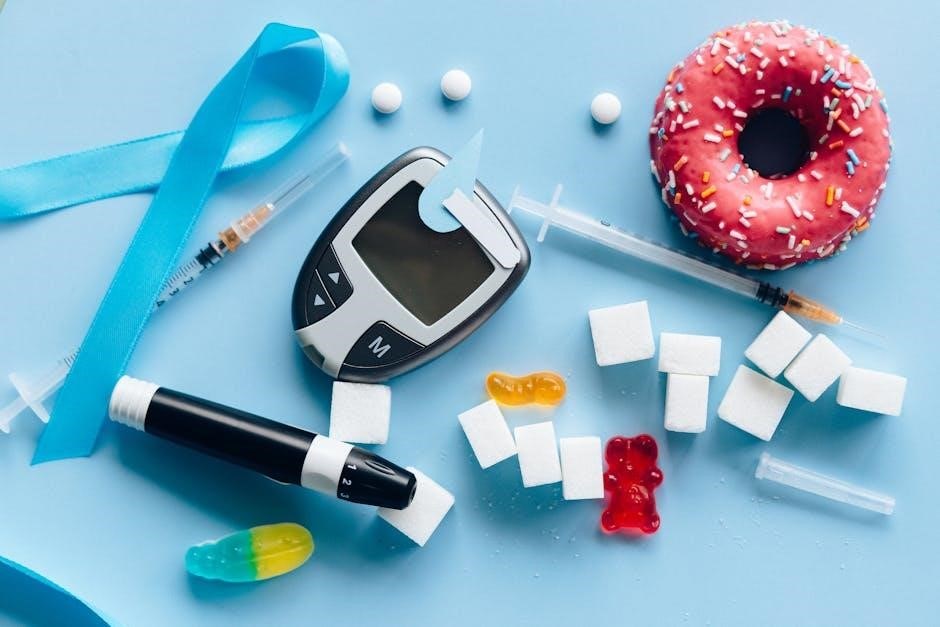Dr. William Li’s groundbreaking approach highlights how specific foods can activate the body’s five defense systems, promoting health and combating diseases through targeted nutrition.
The Core Idea of Using Food as Medicine
The concept of “Eat to Beat Disease” revolves around the belief that food can serve as a powerful tool for preventing and combating illness. By focusing on specific nutrients and compounds found in certain foods, individuals can target and strengthen their body’s defense systems. This approach emphasizes the idea that diet is not just about sustenance but about actively promoting health and longevity. Dr. William Li’s work highlights how foods like berries, green tea, and turmeric can influence biological processes, such as angiogenesis and cell regeneration, to fight diseases. The “Eat to Beat Disease Food List PDF” provides a practical guide to these foods, helping people make informed choices to support their health.
Overview of the Five Defense Systems
The “Eat to Beat Disease” concept identifies five key defense systems in the body that play a crucial role in maintaining health and preventing disease. These systems are angiogenesis, cell regeneration, the immune system, DNA protection, and inflammation control. Each system has a unique function, such as angiogenesis, which focuses on blood vessel growth, and cell regeneration, which repairs damaged tissues. By understanding and supporting these systems through diet, individuals can enhance their body’s natural defenses. The “Eat to Beat Disease Food List PDF” categorizes foods based on their ability to target and strengthen these systems, providing a clear roadmap for optimal health. This approach emphasizes how specific nutrients can activate these defenses, promoting longevity and resilience.

Understanding the Five Defense Systems
The five defense systems—angiogenesis, cell regeneration, immune support, DNA protection, and inflammation control—work synergistically to protect the body. Diet plays a key role in optimizing their function.
Angiogenesis: Boosting Blood Vessel Growth
Angiogenesis is the process by which new blood vessels form, delivering oxygen and nutrients to cells. It’s crucial for healing, growth, and preventing disease. Certain foods, like berries (rich in ellagic acid) and green tea (packed with catechins), naturally support angiogenesis by stimulating vascular growth. These foods promote the formation of healthy vessels, aiding in cancer prevention by cutting off tumor blood supply. Turmeric, with its active compound curcumin, also enhances angiogenesis, supporting tissue repair and reducing inflammation. Incorporating these foods into your diet can optimize blood vessel function, enhancing overall health and longevity. Regular consumption aligns with the “Eat to Beat Disease” approach, emphasizing nutrition’s role in disease prevention.
Cell Regeneration: Repairing and Renewing Cells
Cell regeneration is the body’s ability to repair and renew damaged or aging cells, essential for maintaining health and preventing chronic diseases. Foods rich in omega-3 fatty acids, such as fatty fish (salmon, mackerel), and antioxidants (blueberries, pomegranates) support this process by reducing oxidative stress. Nuts and seeds, particularly walnuts and flaxseeds, provide alpha-linolenic acid (ALA), which aids in cellular repair. Leafy greens like spinach and kale are packed with folate, promoting DNA synthesis and cell renewal. Incorporating these foods into your diet can enhance your body’s natural repair mechanisms, supporting organ function and overall longevity. The “Eat to Beat Disease” food list highlights these regenerative foods, helping you prioritize them in your meals.

The Role of Food in Disease Prevention
Food plays a crucial role in preventing diseases by optimizing nutrient intake, reducing inflammation, and supporting immune function. A balanced diet rich in whole foods helps protect against chronic conditions like heart disease, diabetes, and cancer. By focusing on nutrient-dense foods, individuals can enhance their body’s natural defenses and maintain overall health. The “Eat to Beat Disease” food list PDF provides a comprehensive guide to selecting foods that promote longevity and well-being, making it easier to incorporate disease-preventative choices into daily meals.
Antioxidants and Phytochemicals in Foods
Antioxidants and phytochemicals are essential compounds that protect cells from damage caused by free radicals, reducing the risk of chronic diseases. Found abundantly in fruits, vegetables, and whole grains, these nutrients play a vital role in maintaining health. Berries, leafy greens, and cruciferous vegetables like broccoli are rich in antioxidants like vitamin C and E, while phytochemicals such as polyphenols and carotenoids are found in foods like green tea, tomatoes, and carrots. These compounds help combat inflammation, improve immune function, and even support cancer prevention. The “Eat to Beat Disease” food list PDF highlights these powerhouse foods, providing a clear guide to incorporating them into your diet for optimal health benefits.
Reducing Oxidative Stress and Inflammation
Oxidative stress and chronic inflammation are key contributors to disease progression, damaging cells and tissues over time. The “Eat to Beat Disease” food list PDF emphasizes foods that combat these processes. Antioxidant-rich foods like berries, nuts, and leafy greens neutralize free radicals, while anti-inflammatory foods such as fatty fish, turmeric, and olive oil reduce inflammation. These nutrients work synergistically to protect cells, lower disease risk, and promote overall well-being. By incorporating these foods into your diet, you can effectively manage oxidative stress and inflammation, creating a stronger defense against chronic conditions. This approach is central to the concept of using food as medicine for long-term health.

Top Foods for Each Defense System
Berries, leafy greens, and fatty fish are top foods that boost defense systems by promoting angiogenesis and cell regeneration, enhancing overall health and resilience.
Foods That Promote Angiogenesis
Foods that promote angiogenesis are essential for maintaining healthy blood vessels and preventing diseases.
Berries, such as blueberries and raspberries, are rich in antioxidants that protect blood vessels and enhance angiogenesis.
Leafy greens like spinach and kale provide nitrates, which improve blood flow and support vessel growth.
Fatty fish, including salmon and mackerel, offer omega-3 fatty acids that reduce inflammation and promote vascular health.
Citrus fruits like oranges and grapefruits are high in vitamin C, crucial for collagen production and vessel integrity.
Green tea contains catechins that stimulate angiogenesis, while fermented foods like kimchi support gut health, indirectly aiding blood vessel formation.
Incorporating these foods into your diet can enhance your body’s ability to grow new blood vessels, promoting overall health and disease prevention.
Foods That Support Cell Regeneration
Foods that support cell regeneration are vital for repairing and renewing damaged cells, promoting overall health.
Eggs are rich in choline, essential for cell membrane structure and function.
Avocados provide healthy fats that support cellular repair and reduce inflammation.
Fatty fish, such as salmon and mackerel, offer omega-3 fatty acids that protect cells and aid regeneration.
Sweet potatoes are high in vitamin A, which supports skin and mucosal cell renewal.
Mushrooms, particularly reishi and cordyceps, contain compounds that enhance cell repair mechanisms.
Leafy greens like spinach and kale provide antioxidants and folate, crucial for DNA repair and cell division.
Incorporating these foods into your diet can help your body efficiently regenerate cells, reducing the risk of chronic diseases and improving overall well-being.

Disease-Specific Foods
Certain foods target specific diseases, enhancing recovery and prevention.
Berries and green tea combat cancer by inhibiting tumor growth.
Turmeric and ginger reduce inflammation, aiding arthritis and heart disease.
Fermented foods support gut health, benefiting autoimmune conditions.
Tailoring diets to specific illnesses optimizes healing and disease management.
Cancer-Fighting Foods
Certain foods have potent anti-cancer properties, targeting tumor growth and enhancing recovery. Cruciferous vegetables, like broccoli and Brussels sprouts, contain sulforaphane, which inhibits cancer cell proliferation. Berries are rich in antioxidants that combat oxidative stress, while green tea contains catechins like EGCG, which block cancer cell growth. Fatty fish, such as salmon, provide omega-3 fatty acids that reduce inflammation, a key driver of cancer. Turmeric and garlic also show promise, with curcumin and sulfur compounds targeting cancer pathways. Incorporating these foods into your diet can support the body’s defense systems, enhance immune function, and create an environment where cancer cells struggle to thrive.

Foods for Immune System Support
Foods that support the immune system are essential for maintaining overall health and preventing disease. Citrus fruits, such as oranges and lemons, are rich in vitamin C, which boosts immune cell function. Mushrooms, particularly reishi and shiitake, contain beta-glucans that stimulate immune responses. Garlic is a natural antimicrobial agent, while ginger reduces inflammation and enhances immune defense. Leafy greens like spinach and kale provide essential vitamins and minerals, and fermented foods like yogurt and kimchi support gut health, where much of the immune system resides. Including these foods in your diet helps create a strong defense against pathogens and promotes long-term wellness.

The Eat to Beat Disease Food List PDF
The Eat to Beat Disease Food List PDF is a comprehensive guide to foods proven to support health and prevent disease, backed by scientific research.
Structure and Organization of the List
The Eat to Beat Disease Food List PDF is meticulously organized to provide users with a clear, user-friendly guide to healing foods. The list is divided into categories based on the five defense systems, ensuring each food is linked to its specific health benefits. It includes an alphabetical index of foods, detailed descriptions of their nutritional properties, and scientific evidence supporting their role in disease prevention. Each entry highlights how the food boosts immunity, fights cancer, or supports heart health. The PDF also features practical tips for incorporating these foods into daily meals, making it an invaluable resource for anyone seeking to harness the power of nutrition for optimal health.
Practical Guide for Grocery Shopping
The Eat to Beat Disease Food List PDF offers a practical guide for grocery shopping, helping users make informed choices. It includes a categorized shopping list based on the five defense systems, ensuring users know which foods to prioritize. The guide suggests seasonal and budget-friendly options, reducing grocery costs. Tips on reading food labels and avoiding harmful additives are provided, along with advice on selecting organic versus conventional produce. The PDF also recommends storage methods to preserve nutrients and suggests meal prepping strategies to maintain a balanced diet. This section empowers users to shop smartly, ensuring their pantry is stocked with foods that support their health goals effectively.

Plant-Based Diets and Their Benefits
Plant-based diets emphasize whole, minimally processed foods, reducing chronic disease risk. They are rich in antioxidants, fiber, and phytochemicals, which support immune function and protect DNA from damage.
Supporting the Immune System
A plant-based diet plays a crucial role in bolstering the immune system by providing essential nutrients like antioxidants, fiber, and polyphenols. These compounds help protect immune cells from oxidative damage and enhance their function. Foods such as berries, leafy greens, and mushrooms are rich in beta-glucans and other immunomodulatory compounds that activate immune cells and reduce inflammation. Incorporating these foods into your diet can strengthen your body’s natural defense mechanisms, making it more resilient to infections and diseases. The “Eat to Beat Disease” food list highlights these immunity-boosting foods, offering a practical guide to selecting the best options for optimal immune health.
Protecting DNA and Reducing Inflammation
A plant-based diet is rich in antioxidants and anti-inflammatory compounds that protect DNA from damage and reduce chronic inflammation. Foods like berries, leafy greens, and cruciferous vegetables contain sulforaphane, which activates DNA repair pathways. Omega-3 fatty acids found in fatty fish and flaxseeds help minimize inflammation, while polyphenols in green tea and turmeric inhibit inflammatory responses. These nutrients work synergistically to safeguard DNA integrity and prevent cellular damage. By incorporating these foods into your diet, as outlined in the “Eat to Beat Disease” food list, you can effectively reduce inflammation and promote long-term health. This approach supports overall well-being and helps prevent chronic diseases linked to DNA damage and inflammation.
Scientific Research and Evidence
Extensive clinical trials and peer-reviewed studies validate the “Eat to Beat Disease” approach, demonstrating how specific foods prevent disease through biological mechanisms. Research from institutions like Harvard supports the evidence linking diet to health outcomes. This scientific backing ensures the food list is grounded in proven benefits for disease prevention and overall well-being.
Studies on Food and Disease Prevention
Numerous studies have highlighted the direct link between specific foods and their ability to prevent or manage chronic diseases. Research from institutions worldwide, including Harvard and Stanford, has identified key nutrients and compounds in foods that actively combat disease pathways. These studies form the foundation of the “Eat to Beat Disease” food list, ensuring its recommendations are evidence-based. For instance, berries are proven to reduce cancer risk due to their high antioxidant content, while leafy greens support cardiovascular health by lowering inflammation. The scientific evidence underscores how diet can be a powerful tool in preventing diseases like heart disease, diabetes, and certain cancers.
Dr. William Li’s Contributions
Dr. William Li, a renowned physician and researcher, has made groundbreaking contributions to the understanding of how food impacts health and disease. His work focuses on angiogenesis, the process of blood vessel growth, and how specific foods can inhibit or promote it. Dr. Li’s research has identified foods that can starve cancer cells by blocking their blood supply, while others support healthy blood vessel formation. His findings are central to the “Eat to Beat Disease” food list, providing a science-backed guide for preventing and managing diseases. Dr. Li’s work emphasizes the power of diet in medicine, offering practical solutions for improving health and longevity through targeted nutrition.

Practical Tips for Incorporating Healing Foods
Incorporate healing foods gradually, plan meals weekly, and use the food list as a guide. Focus on variety, seasonality, and whole ingredients to maximize benefits.
Meal Planning and Recipes
Meal planning is essential for incorporating healing foods into your diet. Start by creating a weekly menu using the “Eat to Beat Disease” food list as a guide. Focus on balancing nutrient-dense meals that target specific health goals. For example, include antioxidant-rich foods like berries and leafy greens to combat oxidative stress. Experiment with simple, flavorful recipes such as smoothies, stir-fries, and salads. Pair proteins like fatty fish or legumes with colorful vegetables for nourishing meals. Aim to vary your protein sources and include a rainbow of fruits and vegetables daily. Prepping ingredients in advance can save time and make healthy eating more sustainable. Discover creative ways to incorporate healing foods into familiar dishes to keep meals exciting and beneficial. Over time, these habits will become second nature, supporting long-term health and well-being.
Creating a Personalized Food List
Creating a personalized food list based on the “Eat to Beat Disease” concept ensures you tailor nutrition to your health goals. Start by assessing your dietary needs, preferences, and health conditions. Identify key foods from the PDF that align with your objectives, such as heart health or immune support. Organize your list into categories like proteins, vegetables, and spices for easy reference. Prioritize foods rich in antioxidants, phytochemicals, and anti-inflammatory properties. Adjust portion sizes and frequencies based on your lifestyle and calorie requirements. Regularly review and update your list to reflect changes in your health or preferences. This personalized approach ensures you maximize the benefits of food as medicine, making healthy eating sustainable and effective.

Case Studies and Success Stories
Real-life examples highlight how individuals reversed chronic diseases and improved health using the “Eat to Beat Disease” food list. Inspiring stories show cancer recovery and enhanced heart health.
Real-Life Examples of Disease Prevention
Individuals who adopted the “Eat to Beat Disease” food list experienced remarkable health transformations. A 55-year-old with prediabetes reversed his condition by incorporating antioxidant-rich foods like berries and leafy greens. Another case involved a woman who reduced her risk of heart disease by 30% through regular consumption of omega-3 fatty acids from fatty fish. These examples demonstrate how targeted nutrition can prevent chronic illnesses. The structured food list provided clarity, helping users focus on foods that actively promote health. Many reported feeling more energized and motivated to continue their dietary changes after seeing measurable improvements in blood work and overall well-being.
Improvements in Overall Health
Adopting the “Eat to Beat Disease” food list has led to significant improvements in overall health for many individuals. Users report increased energy levels, improved digestion, and enhanced mental clarity. The emphasis on nutrient-dense foods has helped reduce inflammation, leading to healthier skin and joints. Many have noticed better sleep quality and a stronger immune system. Incorporating foods rich in antioxidants and phytochemicals has also supported longevity and vitality. The structured approach of the food list makes it easier to prioritize whole, unprocessed foods, fostering a balanced diet that promotes long-term well-being. These improvements highlight the transformative power of nutrition in achieving optimal health outcomes.
The “Eat to Beat Disease” food list empowers individuals to harness nutrition’s power, promoting longevity and well-being through scientifically backed dietary choices.
The Importance of Diet in Longevity
Diet plays a pivotal role in longevity by influencing cellular health and overall well-being. A nutrient-rich diet, as outlined in the “Eat to Beat Disease” food list, helps combat oxidative stress and inflammation, key drivers of aging. By incorporating foods that promote angiogenesis and cell regeneration, individuals can support their body’s natural repair mechanisms, fostering resilience against age-related diseases. Prioritizing whole, unprocessed foods like berries, nuts, and fatty fish enhances metabolic function and energy levels, contributing to a longer, healthier life. This approach not only extends lifespan but also improves quality of life, emphasizing nutrition’s profound impact on longevity.
Empowering Yourself Through Nutrition
Empowering yourself through nutrition involves taking control of your health by making informed food choices. The “Eat to Beat Disease” food list PDF serves as a powerful tool, guiding you to select foods that actively support your body’s defense systems. By understanding how specific nutrients impact your health, you can tailor your diet to enhance energy, resilience, and overall well-being. This approach fosters a sense of autonomy, allowing you to proactively prevent diseases rather than merely treating symptoms. A balanced and intentional diet not only improves physical health but also boosts mental clarity and confidence, creating a foundation for a vibrant, empowered life.
